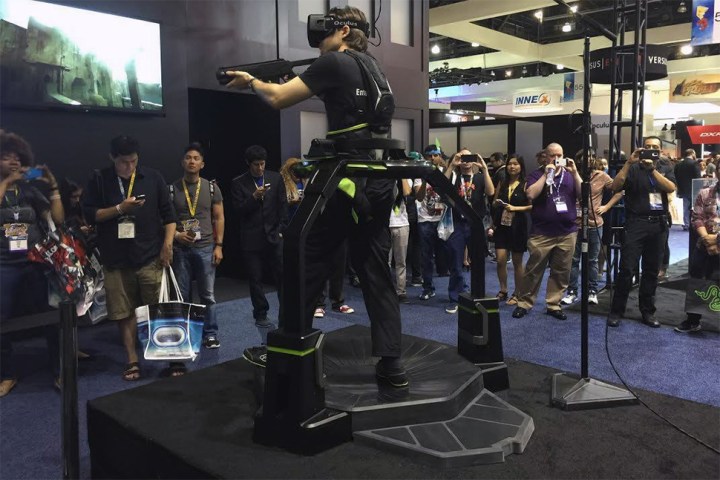
If all you have time for is a crash course of what you might expect to see lining the demo counters and media suites, there are a few key trends to keep an eye out for when the show officially opens on the 6th.
Virtual Reality
Virtual reality may have already dominated the conversation in 2015, but most people will have their first real taste of the technology in 2016. With a Q1 2016 release for the Oculus Rift, and the HTC Vive not far behind in April, it’s a solid bet that every brand surrounding VR tech will bring a wide selection of devices and peripherals to CES.
And there’s room for all at the VR table. Peripherals like the Virtuix Omni and Nullspace VR will let you not only see a new virtual world, but run around in it, and reach out to feel it. Component manufacturers like Nvidia and AMD have been gearing up for release with new hardware and software. Even computer builders are in on the fun with the Oculus Ready PC program. Every company wants you to believe what they sell will be an essential part of the VR experience.

Virtual Reality is the most exciting new technology to hit the PC scene in over a decade, and it has the potential to fundamentally change how we interact with computers. CES 2016 will make obvious the technology’s transformation from proof of concept into something everyone can own and use.
The incredible shrinking computer
While much of CES will be focused on high-end hardware, the other side of the coin will be represented, as well. Tiny computers like the Raspberry Pi, InFocus Kangaroo, and Remix Mini have sprung up seemingly overnight. And Intel has been a big part of that movement over the last year or two with the introduction of the Compute Stick.
We expect to see PC builders come up with new ideas about how to use Intel’s most efficient Core processor.
But manufacturers are ready to move away from the safety of that original Intel design. New miniature PCs are heading our way that pack in better video output with Mini DisplayPort or HDMI 2.0, or improvements to the form factor and power delivery.
Most importantly, these tiny systems are moving towards a slightly larger power envelope with better cooling, which means ditching the obnoxiously slow Atom processors. Intel’s Core M Compute Stick has been rumored for months, and CES seems a likely platform for its launch. Similarly, we expect to see other manufacturers come up with new ideas about how to use Intel’s most efficient Core processor.
These small computers are important for reasons beyond their size, though. They act as something of a stress test for stripping wired connectivity to an absolute minimum, and if the success of limited systems is any indication, more systems with connectivity like the MacBook’s lone USB Type-C connector aren’t far off either.
It’s time to take 3D cameras seriously
Intel debuted a 3D camera called RealSense at CES 2014. Early versions used two sensors to measure disparity, but the newest version of the tech uses an infrared projector and maps a detailed image of the user’s face or an object.
The hardware brings with it some impressive functionality. Not only does it allow Windows Hello, the biometric authentication built into Windows 10, to differentiate between twins, but also offers non-security features like 3D scanning, active background removal for a green screen effect, and gesture controls without touching a screen.

While the initial release of RealSense didn’t catch on, we’ve seen signs that it and other 3D camera technologies have hooked PC makers at CES 2016. We expect to see some systems debuted with a bundled 3D camera, and also some new stand-alone units. As they find their way into systems, they’ll become the norm, and people will forget the standard webcams ever existed.
The wait is almost over
As the traditional PC markets shrinks even further back to appealing just to enthusiasts and gamers, it encourages manufacturers to spread out into new areas, and CES 2016 is going to be primarily a showcase for that expansion.
That means straightforward machines, generic
Editors' Recommendations
- Spatial computing went public this year, but the true test is ahead
- How using these prototype XR glasses sold me on mixed reality gaming
- This futuristic haptic vest should make virtual reality feel more realistic
- The 15 coolest gadgets at CES 2021
- Lenovo’s ThinkReality AR glasses can project virtual desktops into your eyes



